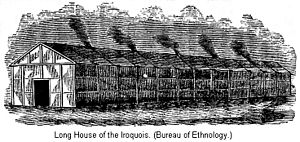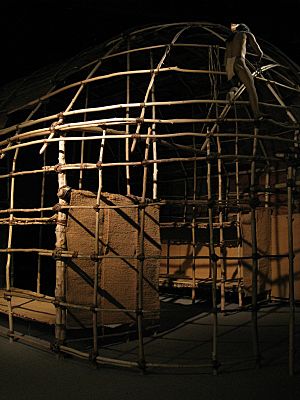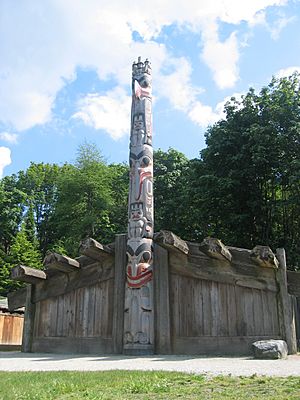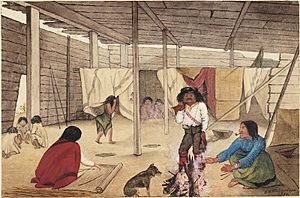Longhouses of the indigenous peoples of North America facts for kids
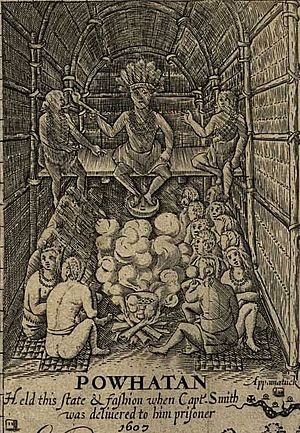
Longhouses were a special kind of long home. Native American and First Nation peoples built them in different parts of North America. Sometimes, they built separate longhouses for important community meetings.
Longhouses of the East Coast
The Iroquois people, also known as the Haudenosaunee or "People of the Longhouses," lived in these homes. They lived in the northeastern United States and parts of Canada (like Ontario and Quebec).
How East Coast Longhouses Were Built
These longhouses could be very long, sometimes over 75 meters (about 246 feet). But they were usually about 5 to 7 meters (16 to 23 feet) wide. Experts think the walls were made from many sharpened poles. These poles were pushed close together into the ground. People then wove strips of bark through the poles. This made the walls strong and helped keep out bad weather.
The roof was made by bending poles into an arc shape. This frame was then covered with leaves and grasses. Finally, bark was sewn onto the roof in layers, like shingles. This made the roof strong and waterproof.
Doors were built at both ends of the longhouse. Animal hides covered these doors to keep the warmth inside. Very long longhouses sometimes had doors on the sides too. Inside, there were fireplaces in the middle for warmth. Holes were made above these fires to let smoke out. But these smoke holes also let in rain and snow. Early visitors often wrote about how dark it was inside these longhouses.
Life Inside an East Coast Longhouse
A typical longhouse was about 24 meters (80 feet) long and 5.5 meters (18 feet) wide and tall. It could house up to twenty or more families! Most of these families were related through the mother's side. The Iroquois had a matrilineal system. This means that property and family names were passed down through the mother's family. Children belonged to their mother's clan.
To keep the village safe, tall fences called palisades were built around the longhouses. These fences were about 4 to 5 meters (14 to 16 feet) high.
Who Built East Coast Longhouses?
Many tribes in northeastern North America built longhouses. These included the five nations of the Iroquois Confederacy: the Seneca, Cayuga, Onondaga, Oneida, and Mohawk. Other Iroquoian peoples like the Wyandot (also called Huron) and Erie also built them.
Some Algonquian peoples built longhouses too. These included the Lenni Lenape who lived near the Hudson River and Delaware River. The Pamunkey people, part of the Powhatan Confederacy in Virginia, also built longhouses.
Even though the Shawnee usually didn't build longhouses, a visitor named Christopher Gist described one. In 1751, he saw a "Kind of State-House" about 27 meters (90 feet) long. It had a light bark roof and was used for important meetings.
Northwest Coast Longhouses
The Native peoples of the Pacific Northwest also built longhouses. Their homes were made with logs or split logs for the frame. Then, they covered them with split wood planks and sometimes extra bark. Cedar wood was a favorite choice. Wealthy families built very large longhouses. For example, the Suquamish Old Man House was about 152 meters (500 feet) long and 12 to 18 meters (40 to 60 feet) wide around 1850.
Design and Life in Northwest Coast Longhouses
Usually, one door of the longhouse faced the shore. Inside, there were many small areas along both sides of a central hallway. These areas were separated by wooden containers, like big drawers. Each small area had its own fireplace. Often, a large extended family lived in one longhouse. They worked together to find food, build canoes, and do other daily tasks.
The gambrel roof, which has two different slopes on each side, was special to the Puget Sound Coast Salish people. The front of these longhouses was often beautifully decorated. They had murals with drawings of faces and symbols of animals like ravens, bears, and whales. A totem pole was often placed outside the longhouse. Sometimes, the totem pole was even part of the entrance.
Who Built Northwest Coast Longhouses?
Tribes along the North American Pacific coast who built longhouses include the Haida, Tsimshian, Tlingit, Makah, Clatsop, Coast Salish, and Multnomah.
Discoveries at Ozette, Washington
At the Ozette Indian Village Archeological Site in Washington, archaeologists found amazing things. Mudslides from around the year 1700 had covered and preserved parts of longhouses.
What Archaeologists Found
In one part of a house where a woodworker lived, they found tools. They even found tools that were only partly made, and wood chips! In another part, a whaler lived. There, they found harpoons and a wall carving of a whale. Benches and looms were decorated with shells. These finds showed how wealthy some families were.
One house had five separate living areas, each with its own cooking fire. The items found in each area showed what the people who lived there did. For example, one area had more bows and arrows. This suggested hunters lived there. Another area had more fishing gear, and another had more harpoon equipment. Some areas had everyday tools, while others had many fancy, decorated items. The whaler's area was full of special things.
How Northwest Longhouses Were Built
These houses were built so that the wall and roof planks could be taken off. This was useful because people moved seasonally. They could take their house planks with them! Upright poles held up rafters, which then held the roof planks. These planks overlapped like tiles. Wall planks were tied between sets of poles. The poles' positions could be changed depending on the length of the boards. Walls simply met at the corners and were not permanently joined. This made them easy to take apart.
There were no windows. Light and air came in by moving the roof planks. Rocks held these planks in place, as they were not fastened down.
Benches raised above the floor were the main furniture. They were placed near the walls. Marks on them showed they were used as work surfaces. Elders remember these benches were also used as beds, with mats rolled out on them.
People stored things behind the benches, along the walls, and in corners. Most of the artifacts were found in these storage spots. The rafters probably also held storage, but the mudflow carried away that part of the houses.
de:Langhaus (Wohngebäude)#Langhäuser der Indianer in Amerika


